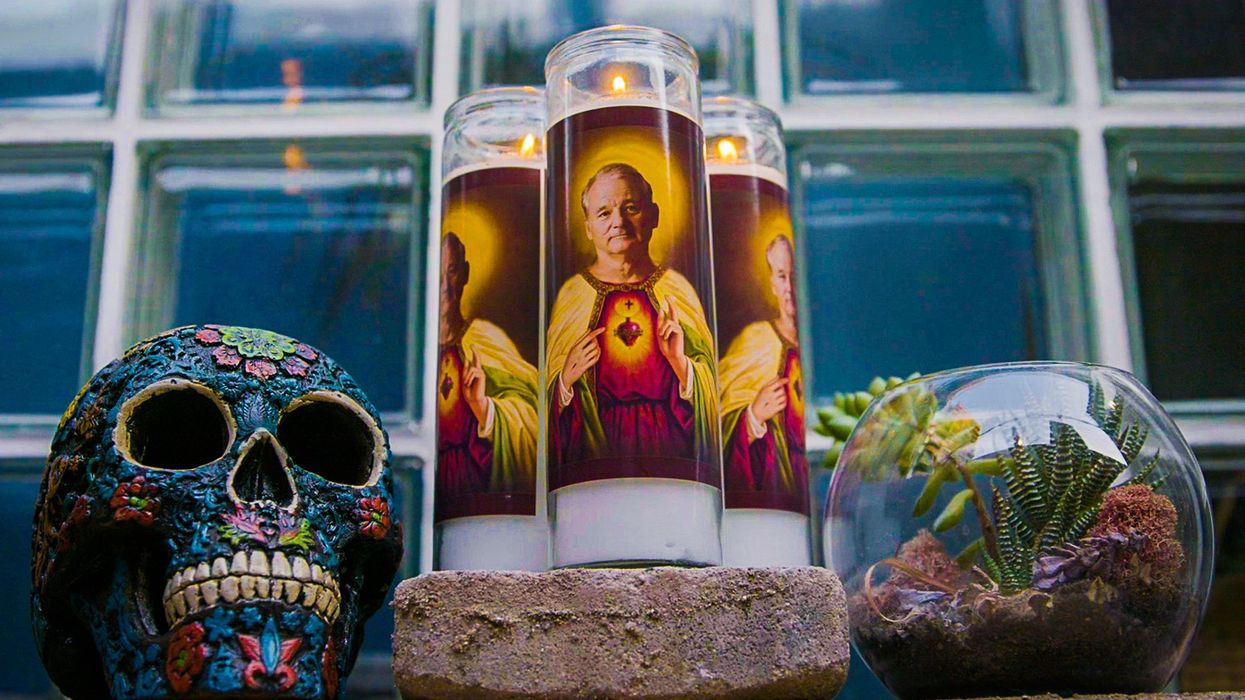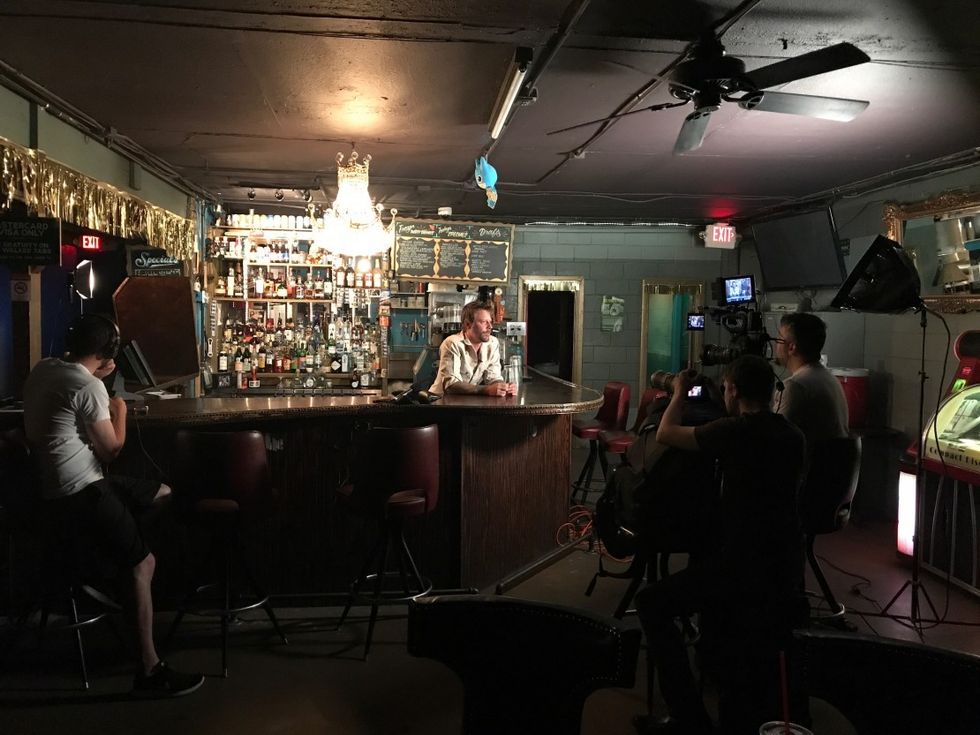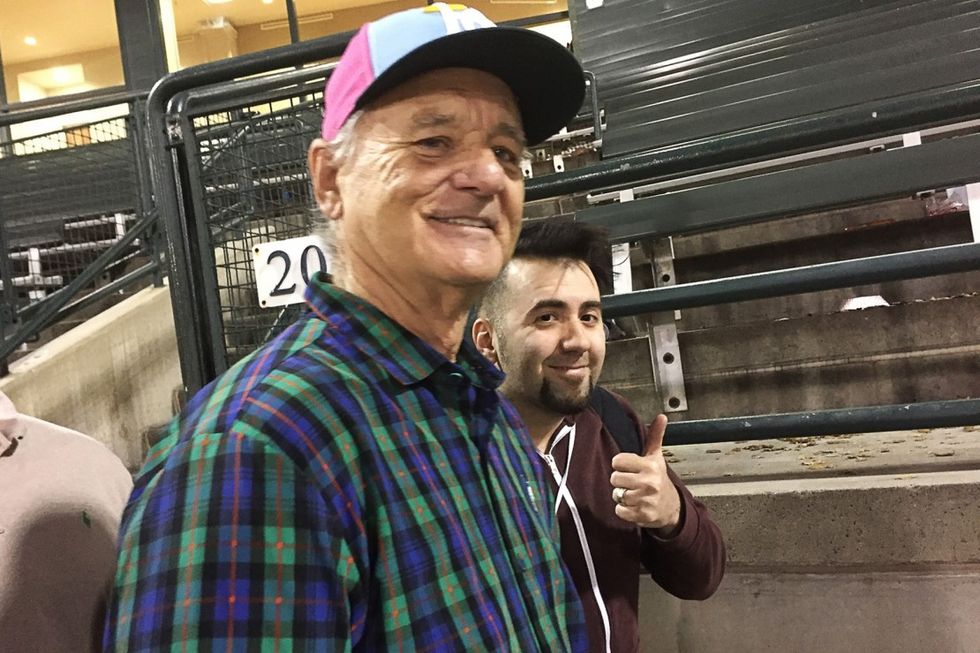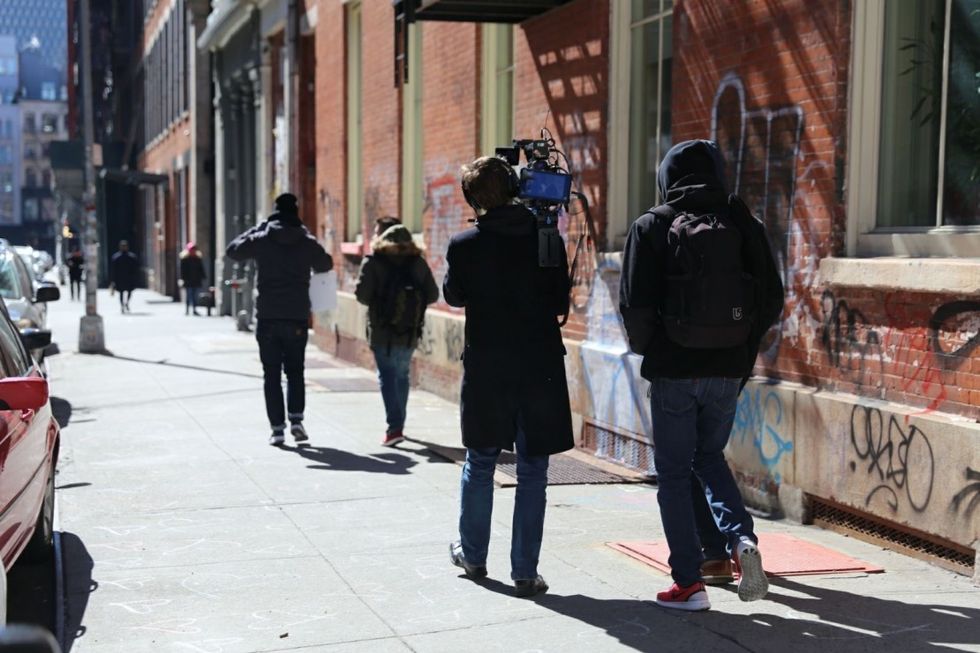Bill Murray Joins RBG and Mr. Rogers as a Documentary Hero—Here’s How it Happened
Filmmaker Tommy Avallone’s journey to self-discovery led him to straight to screen comedy legend Bill Murray.

With the summer box office success of Won’t You Be My Neighbor and RBG, kindness has played surprisingly well with audiences this year. Another surprise comes in an unlikely third documentary protagonist to join Mr. Rogers and Ruth Bader Ginsburg in making kindness cool again: Bill Murray.
Known for his prolific acting career over four decades, Murray has gained cult status in recent years due to his impromptu appearances in everyday people’s lives—at their poetry readings, washing dishes at their house parties, roadie-ing for their bands, joining their engagement photo shoots. That’s precisely the phenomenon that’s captured in Tommy Avallone’s documentary, The Bill Murray Stories: Life Lessons Learned from a Mythical Man.
Avallone and his team traveled the country and abroad getting people to recount their random encounters with Murray, which are illustrated with recreations and real-life captured footage or photographic proof of the “mythical man’s” appearances. An endearing and surprisingly poignant pattern emerges of Murray wanting to put smiles on people’s faces while infusing a little joie de vivre and unpredictability into his own life.
No Film School caught up with Avallone, along with producer Max Paolucci and producer/DP Derrick Kunzer after the film’s premiere at SXSW 2018 to hear about how the project came together.
NFS: Every doc is a passion project, but this one really felt like you were inspired by an idea and just went with it. Tell us about the origins from a production perspective.
Avallone: I directed a previous movie called I Am Santa Claus and Derrick shot and produced it. It was this movie Morgan Spurlock produced, and it came out on Netflix in 2014. The idea was to do Bill Murray stories next. So I started talking with Max [Paolucci] and we all started working together and we filmed two Bill Murray stories and one expert. We put it together, like, this is what we're going to do next.
But as we were filming these things, I was like, "Oh, let's film fans." So we filmed these Ghostbusters fans at New York Comic Con, and we found out that there was this documentary made in Canada on Ghostheads. It was a long one. And I was like, "Well, look. Why don't you give us some questions, we'll ask these Ghostbuster questions for you, because you're not going to come down here." And if you get to Dan Aykroyd or Ivan Reitman, ask them more questions, and we'll just do a swap.
"I knew from the second we talked about it that this was a great idea."
We interviewed this one guy, a Ghostbuster, and we just kind of fell in love with the story and who he was. So I went to Brendan, the director of Ghostheads, and I was like, "Look dude, I think I could very much help this project. I know who this character is." It reminded me a lot of one of those fans we followed, so I was like, "I know how to tell the story." So me and Derrick came on as producers and really put that movie together. We played Tribeca and it's on Netflix right now.
I called people, I put money into that project, and they're like, "Oh great, guys, we love this." We did the Tribeca, we did Netflix, what's next? And I'm like, "Well, we have this sizzle," and that's how it happened. It was just, what are we going to do next, but it was like the stars are not aligned that way, but we had this great sizzle. And when we finished Ghostheads, we were able to do Bill Murray.
NFS: I think a lot of us have these projects in our back pocket. How do you know when to pursue one, and when to let it go?
Derrick Kunzer: I think the nice thing about this one was, I knew from the second we talked about it that this was a great idea, in that these Bill Murray stories were kind of everywhere and they had no lasso, no editorial opinion on them, and everyone really enjoyed them. They were really good Internet fodder. But again, no one had really had put a big bubble around it and said something about it as a whole. Or done any investigation beyond the surface level. So when Tommy, just on a whim, was just talking to me, I was like, "I think this is a great idea. No one's doing this." It was easy.
The hard part after that was research, phone numbers, looking at videos with tags under them, construction workers who don't say their names in a video, trying to find them. The real fun producing stuff was challenging. We were on our own detective journey just to find out who the people were, and then to find the videos, and then to find them.
"By the time we show up with a camera, we have these people who are kind of quiet, and kind of bashful people, come to life."
NFS: Once you find the people you want to feature, how do you convince someone who's never been on camera to be part of your film?
Avallone: You just don't give them a chance to say no. It's cool, no, we're good.
NFS: Tell me more about that.
Avallone: You pay attention to a lot of language and see how it's persuasive. Like don't do it, but a lot of people will say, “Right?” at the end of their sentence, and they're doing it subliminally to kind of get you to agree with them. So you're kind of in your head saying, "Yes. Yes." And it's just simple things. "Tell me, how's your day? Good, right?" "Right." You're not answering it.
But in terms of our films, this is ultimately something they would want to do. They want to tell a story. But the hidden thing in there is well, why me? A camera? I'm not sure if I want to be on camera, and all that stuff. You have to tell them that I'm not going to ask you any questions that you don't know. It's all about you. So it's really just making a fun environment for someone to feel comfortable. And say positive things because you're doing a positive project.
Paolucci: The best part about most Bill Murray stories, though, is people have told them a lot and they've gotten better at telling them. By the time we show up with a camera, we have these people who are kind of quiet, and kind of bashful people, come to life and they at least get the routine of telling their story, and you really see that this is their baby, this telling their story. It was nice to actually put it on film, cement it once, kind of give it a good once-through, and see them come to life for it.

Kunzer: One thing that I would say is that if you're accepting that “no” to being on camera immediately, then you're not passionate enough about what it is. I've known Tommy for a really long time. He's a person who has a lot of drive.
Avallone: And who doesn't like to drive? Derrick 's the one who drives. He drove in London.
Kunzer: I did a lot of stuff. I was their street team a couple days ago.
Avallone: This whole production, there's a lot of slashes in that. Producer slash this, slash that, slash….
Paolucci: This is the table of three people that made this whole movie come together, like there's no hat that doesn't go on. There's no, "Ah, that's not my role." It's just like that needs to get done, all posters got hung up by these three people. All over town.
Avallone: Anytime someone goes, "Should I be doing that?" You just go, "Yeah. Yeah, yeah."
"A lot of the movies that we'll work on, and the ideas that we'll pursue, are based off of the foods that we want to try."
NFS: So what were the pain points of the production?
Avallone: Getting tired.
Paolucci: Yeah. Again, we have resources, and we had great investors on this project, and passionate executive producers, but we make things happen. We make things happen quickly, and cheaply, and efficiently just because we don't want to think about it too much. We find a diner, Tommy goes in. Then he's, "Got us a free diner. We're going in the diner. Those guys are great. They live around the corner from me."
Avallone: That's the weird thing about shooting in New Jersey and Philadelphia.
Paolucci: Yeah. People don't know about site fees.
Kunzer: We'll be walking in there and they go, "Great. You can shoot it for free, but you got to start at eleven." And we're like, "Great." We all work full-time jobs, Tommy has a child, it's just like, "Here we go. Let's do it."
But the best part about making this movie was, we walk in with a camera. We do it, and we get off planes, and you're like, "Where do we eat? We're not eating great." And then you hit record, and you hear these people's stories, and you go, "Oh, yeah. This is a great movie. People are happy. Let's remind ourselves that.” And that was great. When we would walk out of a place, we'd be much happier than when we walked in.
Avallone: And then we get great food. I just want to talk about the food.
NFS: Okay. Talk about the food, please.
Avallone: Well, I feel like that's the whole adventure of these movies, it's like I've never been to Europe before, so we're eating rabbit in London, and what's that mystery meat thing in Scotland?
Paolucci: Really great haggis [sheep's heart, liver and lungs stuffed in a stomach lining].
Avallone: Yeah, haggis. Deep dish in Chicago, buck rate bar-b-que in Austin, great bar-b-que in South Carolina.
Paolucci: But a lot of the movies that we'll work on, and the ideas that we'll pursue, I think are based off of the foods that we want to try.
NFS: A man after my own heart. I like it.
Avallone: We drove to Boston from Jersey to do this one interview that did not make it into the movie, and then we drove an additional hour to go to the Cheers Bar.

Paolucci: It was a good year.
Avallone: 2016, like November, is when we really started filming in South Carolina. And then the wrap-up would have been the UK, really.
Kunzer: Or unless you want to count me driving to and from South Carolina for some additional shots. It took like 24 hours.
Avallone: I would say a year and a half.
NFS: What were the logistics of that? How did you work that out between your day jobs?
Kunzer: It was really just a mess because at that point in time, Tommy lived in L.A., and me and Max are still located in Philadelphia, and as we're putting it together, sometimes you see that there could be a shop that you could use and my thing is, in working on all these, it's just the adventure of doing it and seeing how far I can push myself, and when it came down to, "We could really use some driving shots in South Carolina," it's like I have a 24-hour gap in my schedule. Just get in the car and do it. I think I took a nap at a rest stop.
Avallone: There was a lot of that.
Kunzer: And a lot of that in production and post-production too. Tommy edited the piece, we worked bi-coastally at a certain point, and it was just a lot of mixed media, a lot of hard drives, a lot of Fed-Exing, a lot of Dropboxes. A lot of things can go wrong in that, and it's just, you need a lot of spirit again. It's nice to be watching what you're working on to remind you, just like, keep pushing through. Fixing a lot of problems, putting out a lot of fires. I think technology helped us out a lot on this project.
Paolucci: 17 Terabytes.
"We wanted to make sure that when we put down a tripod, it looked great. And if we had to move, we weren't stopping ruining our rhythm and momentum."
NFS: What did you shoot on, and how did you manage all that media? It seemed like there were a lot of different formats used in the film.
Kunzer: As far as what we shot on, we shot on Canon C300 Mark II, and then the 5D Mark III, and those were our main cameras. The 5D we left for close-ups and interviews, C300s a lot of that b-roll footage, wides on interviews. We tried to rely on that as much as possible, but you know we'd be accounting for a lot of that space on hard drives. And then we even also have some shots in there that are just iPhones. iPhones on a DJI Osmo.
Paolucci: It's an iPhone 7 Plus, just shooting 4K, with Filmic. And that's great, we had the C300, but the thing weighs a ton when you're just running around. So it was about trying to find easy options for stuff like that. This was a film of opportunity for a lot of that stuff. We wanted to make sure that when we put down a tripod, it looked great. And if we had to move, and get real stuff, we weren't stopping ruining our rhythm and momentum.
It being a mixed media piece, we're going all through post. We couldn't have done it in a world where Premiere doesn't just import everything. That makes everything a lot easier. And just our back and forth that way. Again, sending project files and hard drives and syncing all that stuff can be crazy, but with it being a mixed media project, it's to be expected. And just kind of smoothing out all the edges, again, Premiere makes that super easy.

Avallone: I just moved to California in October. The bartender from Austin [one of the storytellers in the movie] lives in California now. I just love that dude. He's like this giant man, super peaceful, just loves the idea of just being free and we should all love each other. And so, one day I was like, "Hey dude, do you want to just go to the Comedy Store or something like that?" And we just hung out and had drinks. It was a really, really fun experience. I don't usually go out of my way to meet new people. And I feel like I got that in a way from how Bill Murray approaches things. It’s just kind of like, "Let's have fun."
Paolucci: I think it's also really nice to just kind of work on something that felt like it had purpose. And we realized that pretty early in production, the purpose of it and kind of takeaway of it. And I felt like the more we were figuring it out, the more we were talking about how people need to get off their phones and kind of be present.
Avallone: I just texted someone.
Paolucci: He texted someone. [Laughs.] It felt like we were building something that also had a poignant message, and something that, hopefully, when people walked out they had something as a takeaway. And that drove us on as we were making it as well.
Kunzer: It's like very relevant to now. By the time we finished the movie, like I don't even have a Facebook account anymore. I deleted it. I wiped it out just because I want to be less in the phone and just more observing the world. I still have Instagram, because I like the idea of it. We're seeing things. I feel like it's more sharing and it's less opinion-based, and I just feel like it gets me more out there and into the world. And my data plan has gone down.











